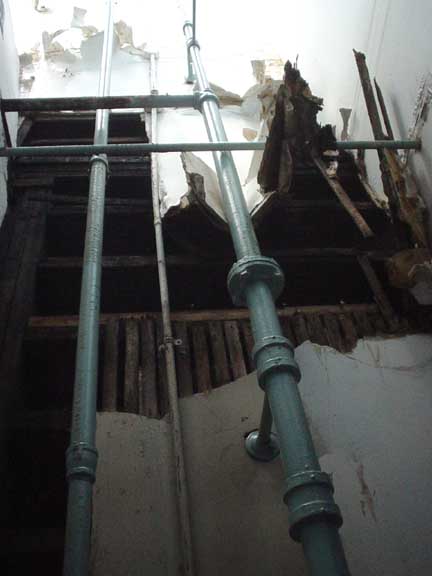Evicted Duluth Artists Scramble to Find Studio Space
Paul Lundgren covers the recent sale of the Corner of the Lake Building in Duluth. For 20 years, this building has housed the best of the city's artists, and its ground floor is occupied by Lizzards Gallery, which sells their work









Richard Gruchalla has been raku-firing pottery on the fourth floor of the Corner of the Lake Building in Duluth for nearly two decades. This summer, his kiln might be homeless.
Gruchalla and a handful of other artists have been served with eviction notices by the building’s new owners, who are considering whether to renovate the century-old structure or demolish it in favor of new construction. One thing is for sure, no matter what the development plan ends up being on the corner of Superior Street and First Avenue East, the days of inexpensive artist studios there are over.
“Panic has set in,” Gruchalla said. “I don’t know that we’re going to find something in the area to replace it. Certainly not at the same price.”
Gruchalla has shared his Corner of the Lake studio for the past ten years with his wife Carrin Rosetti, a weaver. He said the two of them have been spending a lot of time driving around lately, looking at buildings, hoping to find a suitable space to move to.
“Everything’s been fairly expensive so far,” he said, “And it’s too cramped to work at home.”
Just down the hall from Gruchalla is Adu Gindy. She recently retired from her position as an assistant professor at the University of Minnesota Duluth Dept. of Art to spend more time in her approximately 1,500 sq. ft. painting studio. Since receiving her eviction notice, she’s instead spending that time looking for a new studio.
“I love my space,” Gindy said. “I’ve been here since 1989. I’m going to be so sad, but I understand the reality. The building is falling down. It’s too late to save it.”
It’s a problem with no easy answer. Though the Corner of the Lake Building has been perfect for artists—with its large, high-ceilinged studios, close proximity to downtown arts venues, and outrageously inexpensive rents—the building’s poor condition made it impossible for its former owner to maintain. The sale of the building to one of the area’s most prominent development groups may have been inevitable.
“It’s a cool building, but it’s in complete disrepair,” said Chris Monroe, a cartoonist and painter who has had a third-floor Corner of the Lake art space for the past two years. “Water pours into my studio like a waterfall. I can only imagine what it’s like above me.”
Monroe said she has shared her space with “a kaleidoscope of different artists,” splitting the mere $150 rent.
“This is a great part of town, and it was only a matter of time before someone figured that out,” she said. “The artists are like the cockroaches that find the crusty old buildings and move in. But there’s just not another place like this that I know of.”
Indeed, art space in Duluth is becoming a sought-after and expensive commodity. Though two artist cooperatives exist—Washington Studios and Emerson—both are live-in workspaces with rents similar to regular downtown office spaces. For artists that want to keep their workspace separate from their home life, the options are becoming fewer.
Gindy said she is seriously looking at a space in the Pineapple Building on West First Street. She said owner Dan King is in the process of dividing up about 4,000 sq. ft. of space there with an eye on artist renters.
“It’s a great space, but it all hinges on what the rent will be,” she said. Her hunch is that she will end up paying twice as much rent for about half as much space.
Another potential art spot in Duluth could be the old Clyde Iron Works buildings in the city’s West End neighborhood. Gindy said she hasn’t heard if that project (a joint venture between the UMD Fine Arts Dept. and the property’s owner) was officially off the ground yet, so it clearly won’t be ready for tenants any time soon. She said she prefers being downtown anyway, but if the city’s artists began to migrate west, she would consider following along.
Bob Olson, a member of four different bands that share rehearsal space on Corner of the Lake’s second floor, said he has also begun the search for new digs. He hopes to find at least a short-term space soon, but acknowledges it won’t be easy. Although all of the members of his groups are responsible adults, he said musicians in general do not have the best reputation as renters, for obvious reasons. And they can’t pay much.
“Unfortunately, most bands have kind of gone back to their basements,” Olson said.
Forming a committee of local bands and pursuing grants are two ideas Olson is toying with at the moment to potentially solve his problem.
One group of Duluth musicians, the Hog Damage Collective, has been renting the former Dark Horse Theater space on First Avenue West for about a year. Eric Anderson, one of the musicians that uses that space, said about seven or eight bands split the $800 rent, which works out to $21 per person.
Anderson said the collective got lucky when one musician bought a house through a realtor who happened to mention that he owned the old theater space. Before that, Anderson said the search for a decent practice studio was about as easy as “doing somersaults in an Olympic-size pool full of chocolate pudding.”
As for the Corner of the Lake Building, its fate will likely be a wrecking ball this fall and an upscale hotel development in the future. The new owners, A & L Development, have not yet announced their plans.
The Corner of the Lake Building is composed of two old buildings that were combined in the mid-1900s. Not much is known about the history of the two-story section on the eastern side, other than that President Rutherford B. Hayes owned a building at the same location in the late 1800s.
The four-story section is arguably considered a piece of art itself. It was designed by Duluth’s most renowned architect, Oliver Traphagen. Built in 1889 as the Weiland Block, it is one of the oldest extant Traphagen buildings.
Editor’s Note: In a late development, one more Traphagen building on the block has been sold to A & L Development, the firm that now owns the Corner of the Lake Building. This leaves only one building remaining—the Electric Fetus—that is not owned by A & L. If the buildings are all torn down, this would doom a recent designation of the area as an historic district. Because of this, a lawsuit has been filed by Eric Ringsred, who owns the Temple Opera building a block down, as he alleges that his planned use of his property would be damaged by the loss of historic designation.